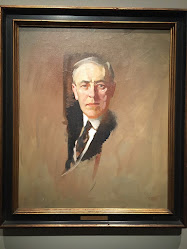A few days ago, Her Majesty Queen Elizabeth II celebrated her 96th birthday. The Queen will celebrate 70 years on the throne this summer (her Platinum Jubilee!). This unique occasion launches the Queen into unfamiliar territory as she becomes Great Britain's longest-reigning monarch as well as one of the longest-reigning monarchs in European history (if she is still on the throne on May 27, 2024 at age 98, she will surpass the reign of Louis XIV of France -- the great "Sun King" who ruled just over 72 years). In the blog post, I am going to detail the amiable relationship between the Lone Star State and Royal Family as well as the Queen's visit to Texas in 1991 (a time when I wish I was alive!).
.jpeg) |
| The Queen, photographed outside Windsor Castle in spring 2022. Queen Elizabeth II, Britain's longest-reigning monarch, will celebrate 70 years on the throne this summer! Royal Family Photographs. |
Throughout its history, Texas has had a friendly relationship with Great Britain. Following the successful Texas Revolution in 1836, the new republic was recognized as a sovereign state by Britain (one of the first nations to do so). When Texas was admitted into the Union in 1945 as the 28th state, Britain continued to have a warm connection with the Lone Star State through its connections with government ambassadors and dignitaries. In 1986, Prince Charles, the Queen eldest son and heir to the throne, visited Texas to help celebrate the Texas sesquicentennial (150 years old!). The Prince of Wales, who had married Lady Diana Spencer five years prior in what was called "the wedding of the century", cut into a 45-ton birthday cake with a Texas-sized sword! At the the state Capitol, the prince was given a giant gavel by legislators. With a smile, he laughed and exclaimed that the huge judicial instrumental was "extremely appropriate coming from Texas." Prince Charles also toured the Alamo and San Antonio (he had briefly visited in 1977, where he had met with progressive Governor Dolph Briscoe).
 |
| Prince Charles, the Queen's eldest son, shakes hands with a follower when he briefly visited Texas in 1977. The Prince of Wales returned to the Lone Star State in 1986. Photograph from MySA News. |
Five years later in 1991, Queen Elizabeth II became the first British monarch to visit Texas. She traveled to Austin, San Antonio, Dallas and Houston, and she loved the Lone Star State!! The Queen reportedly asked her chief of protocol, "why didn't I come here sooner?" She was amused at the beautifully decorated River Walk barge she rode on in San Antonio in addition to NASA and Antioch Mission Baptist Church in downtown Houston. When the Queen arrived at Love Field Airport in Dallas, she was greeted with a very lively crowd and dynamic band playing the western folk-song "The Yellow Rose of Texas." Afterwards, officials sang "God Save the Queen", Britain's national anthem, in hopes the TX audience would not start chanting "My Country 'Tis of Thee," which happens to be the same tune. While in downtown Dallas, the Queen knighted Cecil Howard Green, a cofounder of Texas Instruments (calculators and electronics) and a philanthropist for the University of Texas at Dallas and St. Mark's School of Texas. I recently found out that Green died in early 2003 at the ripe age of 102! What a great life that was blessed by the Queen!!
 |
| The Queen was greeted by Governor Ann Richards in Austin, 1991. Richards was the second woman governor of Texas (1991-1995). Photograph from a Texas Co-op Power Article on the Queen's visit. |
As he used to do, Prince Philip, the Queen's late husband, accompanied his wife on the trip to Texas and dutifully stood by her side, waving to ecstatic onlookers and cracking jokes with government officials. He sat next to Louise Caldwell, president of the Dallas Historical Society, who later remarked, "it was very hard to find anything that he didn't know more about than me, including Texas history." The Duke of Edinburgh was known to be an avid fan of historical and military biographies. When the monarch and her husband arrived in Austin, they were warmly greeted by Governor Ann Richards and a massive crowd of 8,000 well wishers. The Queen declared, "no state commands such fierce pride and loyalty. Lesser mortals are pitied for their misfortune in not being born Texans...", which elicited a thunderous roar of approval. I am glad to hear that the Queen certainly approves of Texas!!

In 1991, the Queen dined with Governor Richards and Lady Bird Johnson, former first lady (1963-1969). Photograph from the LBJ Presidential Library Collections.








